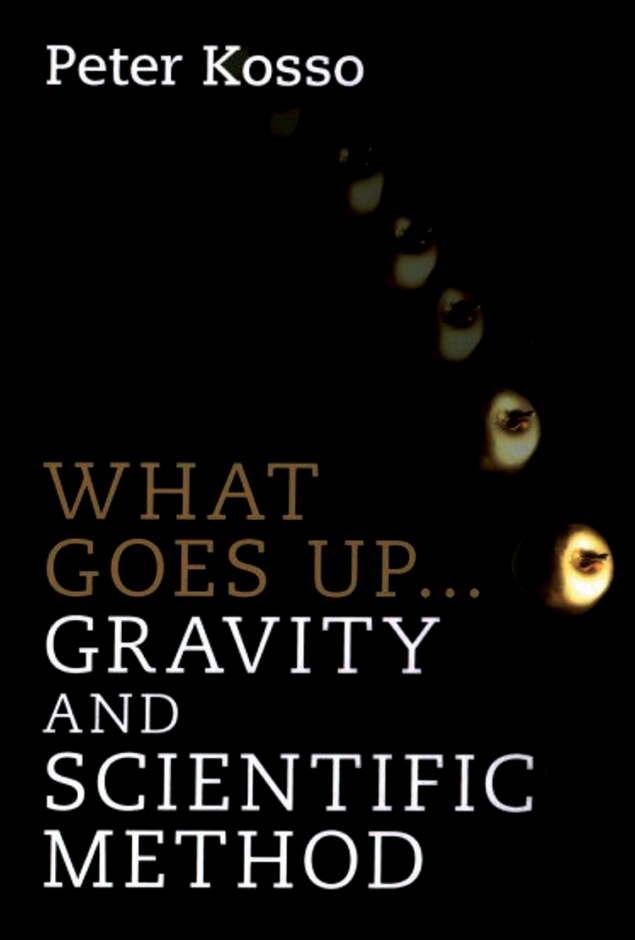
By Peter Kosso
Cambridge University Press

Peter Kosso states that his book is “about the science of gravity and the scientific method”; I would say that it is about how scientific knowledge develops over time, using the historical evolution of our understanding of gravity as a guiding thread. The author has been a professor of philosophy and physics, with expert knowledge on how the scientific method works, and this book was born out of his classes. The topic is presented in a clear way, with certain subjects explored more than once as if to ensure that the student gets the point. The text was probably repeatedly revised to remove any wrinkles in its surface and provide smooth reading, setting out a few basic concepts along the way. The downside of this “textbook style” is that it is unexpectedly dry for a book aimed at a broad audience.
As the author explains, a scientific observation must refer to formal terms with universally-agreed meaning, ideally quantifiable in a precise and systematic way, to facilitate the testing of hypotheses. Thinking in the context of a certain theory will specify the important questions and guide the collection of data, while irrelevant factors are to be ignored (Newton’s famous apple could just as well have been an orange, for example). But theoretical guidance comes with the risk that the answers might too easily conform to the expectation and, indeed, the nontrivial give-and-take between theory and observation is a critical part of scientific practice. In particular, the author insists that it is naïve to think that a theory is abandoned or significantly revised as soon as an experimental observation disagrees with the corresponding prediction.
Considering that the scientific method is the central topic of this book, it is surprising to notice that no reference is made to Karl Popper and many other relevant thinkers; this absence is even more remarkable since, on the contrary, Thomas Kuhn is mentioned a few times. One might expect such a book to reflect a basic enlightenment principle more faithfully: the price of acquiring knowledge is that it will be distorted by the conditions of its acquisition, so that keeping a critical mind is a mandatory part of the learning process. For instance, when the reader is told that the advancement of science benefits from the authority of established science (the structural adhesive of Kuhn’s paradigm), it would have been appropriate to also mention the “genetic fallacy” committed when we infer the validity and credibility of an idea from our knowledge of its source. The author could then have pointed the interested reader to suitable literature, one option (among many) being Kuhn vs. Popper; the struggle for the soul of science by Steve Fuller.
What goes up… is certainly an excellent guide to the science of gravity and its historical evolution, from the standpoint of a 21st-century expert. It is interesting, for instance, to compare the “theories of principle” of Aristotle and Einstein with the “constructive theory” of Newton. While Newton started from a wealth of observations and looked for a universal description, unifying the falling apple with the orbiting Moon, Einstein gave more importance to the beauty of the concepts at the heart of relativity than to its empirical success. I enjoyed reading about the discovery of Neptune from the comparison between the precise observations of the orbit of Uranus and the Newtonian prediction, and about the corresponding (unsuccessful) search for the planet Vulcan, supposedly responsible for Mercury’s anomalous orbit until general relativity provided the correct explanation. And it is fascinating to read about the “direct observation” of dark matter in the context of the searches for Neptune and Vulcan. It is important (but surely not easy) to ensure “that a theory is accurate in the conditions for which it is being used to interpret the evidence”, and that it is “both well-tested and independent of any hypothesis for which the observations are used as evidence”.
The text is well written and accessible. My teenage children learned about non-Euclidean geometry from figures in the book and were intrigued by the thought that gravity is not a force field but rather a metric field, which determines the straightest possible lines (geodesics) between two points in space–time. I think, however, that progress in humankind’s understanding of gravity and related topics could be narrated in a more captivating way. People who prefer more vivid and passionate accounts of the lives and achievements of Copernicus, Brahe, Kepler, Galileo, Newton and many others would more likely enjoy The Sleepwalkers by Arthur Koestler or From the Closed World to the Infinite Universe by Alexandre Koyré. I also vehemently recommend chapter one of Only the Longest Threads by Tasneem Zehra Husain, a delightful account of Newton’s breakthrough from the perspective of someone living in the early 18th century.





